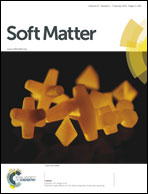Spontaneous and field-induced mesomorphism of a silyl-terminated bent-core liquid crystal as determined from second-harmonic generation and resonant X-ray scattering
Abstract
The polarity and structure of the phases of a liquid crystal constituted by thiophene-based bent-core molecules is investigated by means of optical second-harmonic generation (SHG), and resonant and conventional X-ray diffraction. The material studied is representative of a wide family of mesogens that contain silyl groups at the ends of the chains. These bulky terminal groups have been reported to give rise to smectic phases showing ferroelectric switching. However, the analysis of the SHG signal before and after application of electric fields has allowed us to establish unambiguously that the reported ferroelectricity is not intrinsic to the material but stabilized by the cell substrates once an electric field has been applied. In addition, the results obtained from resonant X-ray diffraction indicate that virgin samples have antiferroelectric undulated synclinic smectic structures.


 Please wait while we load your content...
Please wait while we load your content...